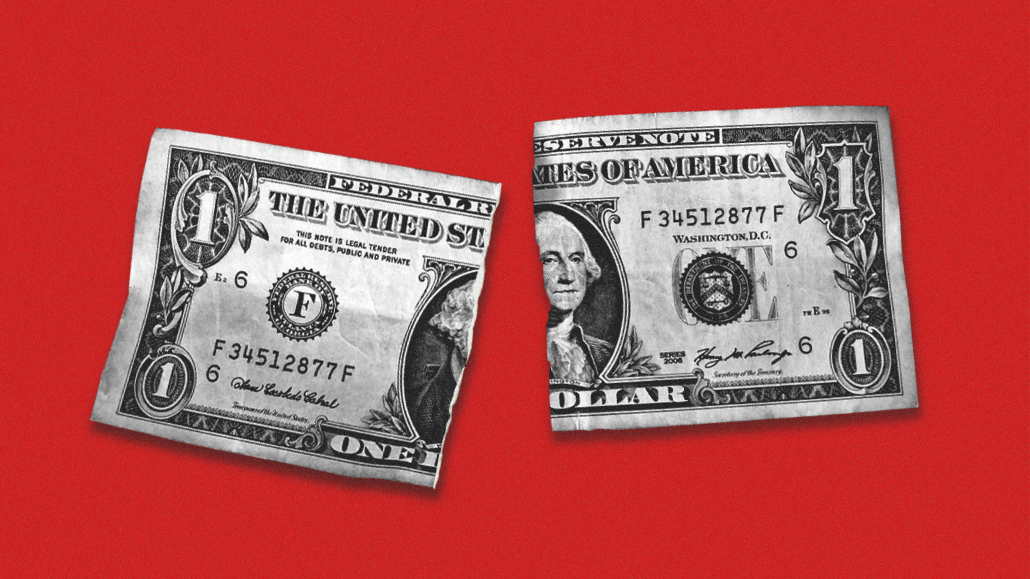Register by Jan 13 to save on passes and connect with marketers from Uber, Bose and more
Media Buying Briefing: Have media agencies really spent half their upfront dollars on streaming?

This Media Buying Briefing covers the latest in agency news and media buying for Digiday+ members and is distributed over email every Monday at 10 a.m. ET. More from the series →
They say a watched pot never boils. That isn’t stopping media agency buyers from keeping a close eye on the ad spend flowing to streamers as this year’s TV upfronts season approaches the finish line.
By some counts, we’re on the cusp of streamers like Netflix and Amazon, alongside a bevy of FAST channels, nabbing half the dollars on the table — a significant tipping point. By others’ estimates (there’s no way of knowing for certain, since there’s no one organization or body that tallies up who spent what where in the upfront season) there’s still some waiting to do.
One educated guess came from IPG Mediabrands’ global chief negotiations officer Dani Benowitz, speaking at last Tuesday’s Digiday CTV Strategies event in Manhattan. Evaluating this year’s marketplace activity in general, Benowitz said her team estimates that around 50% of all upfront dollars have gone to streaming — for the first time ever in an upfront.
Some would argue whether that 50% parity has been reached, but there’s seemingly only one direction the ad dollars are headed — and that’s toward where the viewers are, in streaming and CTV.
According to Benowitz, viewers 18-plus, 45% of that demographic’s time spent in video is in streaming, and 70% of that 45% is in ad-supported streaming. It would make sense that’s where ad dollars will make their way in larger numbers.
Her team at Magna, the intelligence and buying arm for IPG Mediabrands, estimates that some $12 billion will be spent on streaming in this year’s upfront, an amount Magna forecasts to reach $14 billion next year.
Benowitz’s guesstimate was echoed by some in the industry, but also questioned by others.
“That tracks with what we’re seeing across the market,” observed Chris Matheson, media director at Markacy. “CTV is now capturing 50%-plus of upfront precommitted dollars for major players, driven by platforms like YouTube, Hulu, Roku, Amazon, and the rise of FAST networks … That 50% figure feels like a floor, not a ceiling, as we look toward 2026.”
“We are seeing that accelerated shift away from traditional TV,” said Natalee Geldert, PMG’s head of emerging services. Streaming, she added, is “leading the growth in the total upfront spend.”
Geldert declined to provide an estimate for the agency’s client upfront spend, but she told Digiday that upfront commitments with linear TV networks had trended downward or flat — owing to streamers siphoning off spend and some advertisers pivoting away from linear and toward “performance centric” digital channels in response to economic anxiety and tariff fears.
Linear TV remains a magnet for ad dollars looking to latch onto live sports and events, but as this upfront season has shown, sports is now migrating to other digital channels for several reasons. The Amazons and Netflixes of the world not only have the money to battle — and win — major sports rights, but they offer deeper insights into the effectiveness that comes with advertising there.
“While linear TV still holds relevance, especially for tentpole events, advertisers are leaning into the targeting, measurability, and flexibility of streaming,” added Matheson.
Dave Campanelli, president of global investment at Horizon Media, who also spoke at CTV Strategies, said sports has become its own daypart in some ways.
“It transcends linear and streaming,” said Campanelli. “There’s no big distinction between NFL on Amazon or on NBC — it’s the same live experience.”
He did note that since getting in and out of streaming services can be a bit harder than just changing the channel, some streaming might have more “stickiness” for viewers — which can be an advantage for advertisers.
But not everyone believes streaming has reached upfront dollar parity with linear just yet. “Consumption is above 50% on streaming, but the dollars have not followed suit on exactly that ratio for a lot of reasons — ad load being a good example,” said Jason Fairchild, CEO of TV Scientific. But even Fairchild acknowledged that parity is ultimately inevitable.
“I do think the upfront, as it relates to the top 500 or so advertisers, is a leading indicator of where the market is going,” he said. “The rest of the market will soon follow. Those ratios will hit 50% in the not too distant future. I just don’t think we’re there yet.”
Ironically, what’s holding back a surge of smaller, more performance-driven advertisers that are active on search or social, is lack of similar effectiveness measurement, said Fairchild — but again, it’s taking time to get there.
“We will get a million or more advertisers into connected TV that do measure TV in the same way as they measure social for example, but it’s just early on that front,” he said.
So, of all the streamers out there, which ones are doing better than others? Geldert said that Netflix was getting a decent chunk of dollars this time around: “They’re gaining traction quickly.”
And Netflix’s latest earnings showed a solid increase in revenue, to the point where the streamer expects to double ad revenue in fiscal year 2025. Greg Peters, Netflix’s co-CEO, said the company has largely wrapped its upfront negotiations, and cited subscriber growth and easier purchasing ability by advertisers and agencies (thanks to its ad-tech stack rollout) as contributing to better-than-expected ad growth.
Color by numbers
As the upfront winds to a close in the next week or so, the IAB’s full report on digital video ad spend and strategy (part two of a report first released in April) seems timely. According to the report, the promise of CTV is in improved quality of content, but the main drawback is the lack of outcomes measurement. Overall the sector is predicted to grow 14% over 2024 to $72.4 billion. Some other stats from the report:
- 86% of buyers are using/planning to use generative AI in some for to build video ad creative;
- The increasing amount of live content on streaming platforms has led over 40% of buyers to expect incremental audience reach, along with real-time signals and interactive elements.
- With programmatic buying more prevalent, buyers now expect nearly half (47%) of their CTV inventory to be biddable, a nearly 40% hike from 2024 to 2025.
Takeoff & landing
- Publicis and Omnicom released their Q2 earnings last week, with Publicis again delivering strong results for the year’s first half, and Omnicom not as much. Publicis delivered 11% growth in total revenue over H1 2024, with organic growth of 5.4% and an operating margin rate of 17.4%. Omnicom grew revenue by 3%, along with organic growth of 3% and its operating margin rate at 15.3%.
- Cheil North America merged two of its agencies last week to form a new media agency called Attention Arc. Formed from the media side of McKinney put together with Lockard & Wechsler Direct, the 150 person shop will be co-led by Swapnil Patel of McKinney and LWD’s Asieya Pine.
- Personnel moves: WPP named Baiju Shah to be the new global CEO of AKQA, coming over from Accenture Song where he was global chief strategy officer … Dentsu Asia-Pacific named Mimi Lu head of insight and intelligence and Richard Reid head of media strategy … Stagwell’s Assembly Global tapped Farhad Miah to be its chief client officer for the MENA region, a new position … Independent Collective Measures named ex-Digitas executive Michael Kahn to its board of directors and hired Jamie Moran to be its vp of client service, coming over from Colle McEvoy where she was an svp.
Direct quote
“Clients aren’t stupid —they’re just busy … they’re trying to get answers. If you look at the new ad formats, [they] gets to answers.”
—Albert Thompson, director of digital innovation at Walton Isaacson, speaking onstage at Digiday’s CTV Strategies event in New York on July 15.
Speed reading
- Seb Joseph took a step back from the numbers of Publicis’ H1 earnings as well as Omnicom’s, to understand the forces that are shaping the direction of those numbers.
- In his latest Future of TV Briefing, Tim Peterson dug into the measurement issues roiling and messing up this year’s upfront marketplace.
- Sam Bradley and Krystal Scanlon tag-teamed to understand what’s appealing to marketers and media agencies with Google’s latest pitch for YouTube.
More in Media Buying

Omnicom Media’s Adamski: clients are the only ones not complaining about principal media
The global CEO of Omnicom Media now has six agency brands and Acxiom under his control, and he’s expected to maintain consistent growth among them.

Omnicom Media tackles frequency issues in TV via partnerships with Amazon and Roku
The partnership brings together Acxiom data, Omni insights and Roku audience info through Amazon Ads to help solve for better camapign frequency management.

At CES, Omnicom Media says Walmart purchase insights help it make better use of Meta’s influencer followers
The partnership connects Walmart customer purchase data with Meta’s raft of influencers (via Instagram) to empower Creo to to help brands identify potential creator partners.








